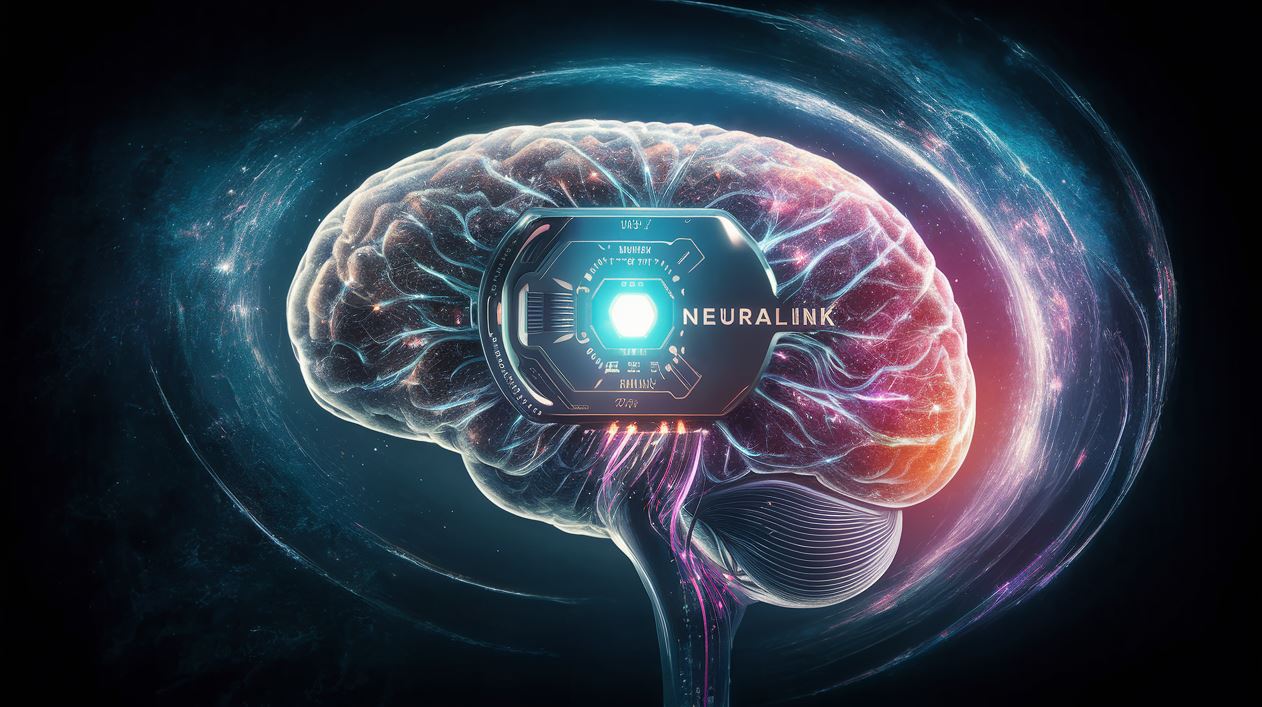Neuralink is a neurotechnology company founded by Elon Musk that is developing implantable brain-computer interfaces (BCIs). The company’s mission is to create a brain interface to restore autonomy to individuals with unmet medical needs and unlock human potential.
What is Neuralink working on?
Neuralink is developing a thin, flexible implant containing microscopic threads that are inserted into the brain. These threads record brain activity, which is then transmitted wirelessly to a device worn behind the ear. The company claims their BCI will be:
- Fully implantable: Unlike some other BCIs, Neuralink’s device is designed to be entirely implanted under the skin, making it invisible.
- Control devices: Users could potentially control computers, mobile devices, or other external devices using their thoughts.
- Medical applications: Neuralink is also exploring potential medical applications for their technology, such as helping people with paralysis regain control of their limbs or restoring lost vision.
How does the Neuralink chip work?
Neuralink’s brain-chip technology works by implanting a small, coin-sized device under the skull, which is connected to ultra-thin wires that fan out into different sections of the brain. These wires, called threads, are flexible and can move with the brain, minimizing damage to surrounding tissue. The threads are inserted into the brain using a custom-designed robot that places them with precision. The device can record neural activity at a high resolution, allowing for more accurate and precise data collection. The electrode threads are made of a flexible biocompatible polymer, meaning they can be safely implanted into the brain without causing harm. The device can process vast amounts of neural data in real time and provide feedback to the user. The N1 chip, which is the heart of Neuralink’s technology, is custom-designed to act as a translator between the human brain and the computer, allowing for real-time communication between the user and the computer
What is the current status of Neuralink’s technology development?
Neuralink’s technology development is still ongoing and has recently achieved significant milestones. While the company’s efforts are indeed in progress and have shown promising advancements, recent reports indicate a notable step forward. In January 2024, Neuralink achieved a significant milestone by conducting its first human implant, marking a pivotal moment in the development of its brain-computer interface (BCI) technology. This suggests that while the technology is still being refined, it has progressed beyond the early stages, signaling potential advancements in the field of neurotechnology.
When did Neuralink initiate its first human trial for its BCI?
Neuralink received approval for human trials in the US in 2023, and while the exact date of the first human trial isn’t widely reported before January 2024, the company has made significant strides in this area. The announcement of the first human implant in January 2024 marked a significant milestone in Neuralink’s journey. However, concerns regarding the ethics and safety of conducting human trials with such novel technology have been raised.
What are the risks associated with Neuralink’s brain-chip technology?
The risks associated with Neuralink’s brain-chip technology encompass a range of potential concerns:
- Infection and inflammation: Implantation of the device involves brain surgery, which carries significant risks such as infections and inflammation. These complications can potentially increase the risk of developing conditions like Alzheimer’s disease later in life.
- Brain injury or infection: Incorrect implantation of the Neuralink device can lead to brain injury or infections, further exacerbating the risk of inflammation and potential long-term neurological consequences.
- Privacy concerns: Neuralink’s technology has raised concerns about privacy invasion due to its ability to read thoughts and record memories. This could potentially lead to unauthorized monitoring of individuals’ thoughts and actions by governments or private entities.
- Addiction: The accessibility of super-human abilities through brain-computer interfaces may result in addiction among users. This addiction could stem from a desire to constantly utilize the enhanced capabilities provided by the interface, potentially leading to psychological issues such as depression.
- Expense: The high cost of Neuralink’s BCI hardware could pose a barrier to access for many individuals, limiting its availability primarily to those who can afford it. This could exacerbate socioeconomic disparities in access to advanced neurotechnology.
- Difficulty in removing or repairing BCIs: There is a risk that Neuralink’s BCIs may fail over time, with limited options available for repair or removal. This could potentially result in irreversible damage to the brain if complications arise.
- Cybersecurity risks: The possibility of hacking Neuralink’s brain chip poses significant cybersecurity concerns. Past incidents of medical device hacks have demonstrated the potential for serious consequences, including life-threatening situations if a hack were to occur with Neuralink’s technology.
- Long-term effects: Limited research exists on the long-term effects of BCIs on humans, making it difficult to fully assess the potential risks and side effects associated with prolonged use of Neuralink’s technology. Further research and monitoring are necessary to better understand these long-term implications.
How does Neuralink’s technology differ from other brain-computer interface technologies?
Neuralink’s Unique Features:
- Implantable and Wireless Design: Unlike traditional BCIs, Neuralink’s interface is fully implantable and cosmetically invisible. This innovative design allows users to wirelessly control computers or mobile devices, providing a seamless user experience and enhanced mobility.
- Advanced Electrode Design: Neuralink’s thin, flexible threads feature 1024 electrodes distributed across 64 threads, offering a less invasive alternative to traditional brain implants. This design minimizes damage during implantation and ensures precise interfacing with neurons, enhancing both safety and effectiveness.
- Surgical Robot: Neuralink utilizes the R1 surgical robot for precise implantation of the N1 device into the brain. This robotic system plays a crucial role in ensuring the safety and accuracy of the implantation procedure, setting Neuralink apart in terms of precision and reliability.
- Decoding Neural Signals: The N1 Implant captures a vast array of neural signals, enabling the transmission of these signals wirelessly to decode actions and intents through the Neuralink Application. This real-time decoding of neural data into actionable computer commands distinguishes Neuralink’s technology in terms of functionality and usability.
Comparison with Other BCIs:
While other companies such as BrainCo and Emotiv focus on brain-machine interface technologies, Neuralink’s emphasis on creating a symbiotic relationship between humans and AI through its advanced neural interfaces sets it apart. Neuralink’s vision and scope extend beyond traditional BCI applications, aiming to facilitate a seamless integration of human cognition with artificial intelligence.
In Summary:
Neuralink’s technology stands out due to its fully implantable and wireless design, advanced electrode technology, utilization of a surgical robot for precise implantation, and real-time decoding of neural signals for computer control. These unique features position Neuralink at the forefront of brain-computer interface technologies, offering unparalleled functionality and potential for transforming human-computer interaction.
Can you register for their clinical trials?
Yes, individuals can register for clinical trials at Neuralink by joining their Patient Registry. Neuralink has one clinical trial available for enrollment, known as the PRIME Study. This study is a groundbreaking investigational medical device trial for their fully implantable, wireless brain-computer interface (BCI). The PRIME Study aims to evaluate the safety of the implant (N1) and surgical robot (R1) and assess the initial functionality of the BCI for enabling people with quadriplegia to control external devices with their thoughts. To participate in the Patient Registry and potentially qualify for current and future Neuralink clinical trials, individuals can fill out a brief screener to determine their eligibility.






